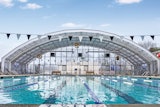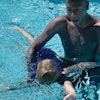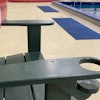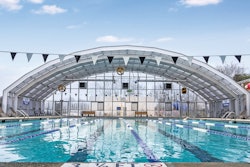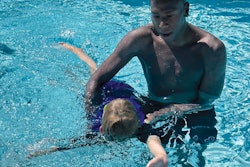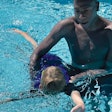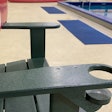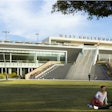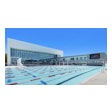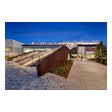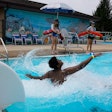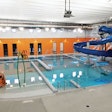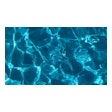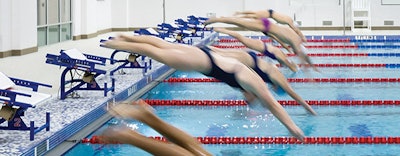
Swimmers, take your marks — Bang! This issue's purchasing guide will help get your athletes off to their best start with a rundown of what to consider when selecting just the right starting blocks for your aquatics facility.
Price
Price points for aquatics starting blocks range from $1,500 to $4,000 each, depending on quality of materials and features.
Size and dimensions
Your provider should help you choose starting blocks that are the right fit for your pool. This involves careful calculation that considers the total height of the block itself, the water depth, the distance from the pool deck to the water's surface, and how far the mount will need to be set back from the deck edge.
RELATED: PRODUCT SPOTLIGHT 2019: Aquatic Components
Mounting
Starting blocks can be mounted to the pool deck in a variety of ways. Some blocks are bolted to a flange on the deck's surface, while others feature single or double posts that fit into anchor sleeves that are mounted within the deck. If yours is a pool dedicated entirely to competition, you might not be as concerned about the easy removal of your blocks. However, if yours is a multi-use facility that also hosts learn-to-swim classes or a sport such as water polo, you might consider blocks that can be easily removed and replaced. It's important to note that when upgrading to new blocks, some manufacturers can custom retrofit for existing deck-mounting hardware, which might cut down on costs.
Custom branding
Many starting block vendors and manufacturers offer customization options, which include team/school colors, logos, ad placements and lane numbering.
RELATED: Aquatics Programming for Fun and Profit
Timing integration
Some starting blocks come with embedded sensors that can be integrated with popular timing systems. These kinds of components — start sensors and speakers — can either be designed into the block itself or added as an upgrade to some blocks after the initial purchase is made.
Backstroke grips
A range of grip positions are available for backstroke swimmers. Grips can come in either horizontal or vertical orientations, or a combination of both. Check with your swimming association on what is required.
RELATED: Find more solutions for your facility in the Buyers Guide
Finish
Starting blocks are naturally a high-risk location for slip-and-fall accidents, but swimmers also need aggressive traction underfoot to ensure their best start. Many blocks feature grooved platforms that allow water to easily drain from the surface, and nearly all manufacturers offer gritty coatings that provide additional traction. For the block's remaining surfaces, some manufacturers offer powder coating, which can protect hardware from corrosion and be customized with everything from solid team colors to sparkles and other stylish flare.
Track start wedges and side rails
Adjustable side rails and track wedges provide the best starts for swimmers. The adjustable start wedge allows swimmers a stronger push-off, and side rails enable swimmers to get farther out over the water than if they were starting with their hands in front of them at the edge of the block. While more expensive, these features are highly regarded among swimmers and coaches.
This article originally appeared in the April 2019 issue of Athletic Business with the title "Purchasing Guide" Athletic Business is a free magazine for professionals in the athletic, fitness and recreation industry. Click here to subscribe.









